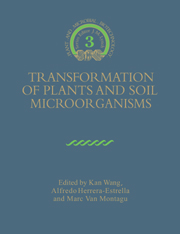Book contents
- Frontmatter
- Contents
- List of Contributors
- Series Preface
- Preface
- Acknowledgements
- Abbreviations and Terms
- Part I Transformation of Soil Microorganisms
- Part II Transformation of Cereal Crops
- 5 Rice Transformation: Methods and Applications
- 6 Maize
- 7 Barley, Wheat, Oat and Other Small-Grain Cereal Crops
- Part III Transformation of Industrially Important Crops
- Index
5 - Rice Transformation: Methods and Applications
Published online by Cambridge University Press: 04 August 2010
- Frontmatter
- Contents
- List of Contributors
- Series Preface
- Preface
- Acknowledgements
- Abbreviations and Terms
- Part I Transformation of Soil Microorganisms
- Part II Transformation of Cereal Crops
- 5 Rice Transformation: Methods and Applications
- 6 Maize
- 7 Barley, Wheat, Oat and Other Small-Grain Cereal Crops
- Part III Transformation of Industrially Important Crops
- Index
Summary
Introduction
Genetic transformation offers new approaches to many fundamental problems in plant biology. In particular, transgenic plants are essential tools in understanding in vivo functions of plant genes and molecular mechanisms of their regulation (Schell, 1987). In addition, genetic transformation provides novel approaches to crop improvement. Early examples are herbicide- (Comai et al.> 1985; De Block et ah, 1987), virus- (Powell-Abel et al, 1986) and insect- (Vaeck et al, 1987; Perlak et al., 1990) resistant dicotyledonous crops such as tobacco and potato. Recently, to improve agronomically important traits, more sophisticated strategies have been designed and applied to a number of crop species (Fraley, 1992).
In contrast to dicotyledonous species, production of transgenic monocotyledonous (monocot) plants has been difficult despite extensive efforts over many years. Because of this, expression of genes derived from monocot species is often examined in transgenic dicot species (Lamppa, Nagy & Chua, 1985; Keith & Chua, 1986; Colot et al, 1987; Ellis et al, 1987). However, increasing evidence obtained from transgenic experiments suggests that there are differences in regulation of gene expression between monocot and dicot species. Monocot genes are not always expressed correctly or at all in transgenic dicot plants (Keith & Chua, 1986; Colot et al, 1987; Ellis et al. 1987). Moreover, anatomical differences between monocot and dicot species often make it difficult to evaluate accurately tissue/cell specific expression of monocot-derived genes in transgenic dicot plants (Schernthaner, Matzke & Matzke, 1988; Lloyd et al., 1991; Matsuoka & Sanada, 1991).
- Type
- Chapter
- Information
- Transformation of Plants and Soil Microorganisms , pp. 53 - 64Publisher: Cambridge University PressPrint publication year: 1995



